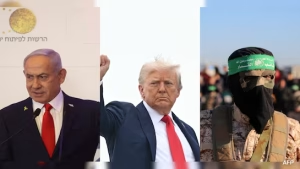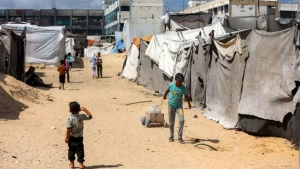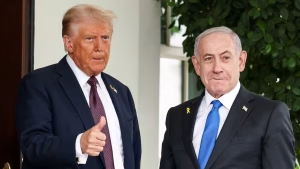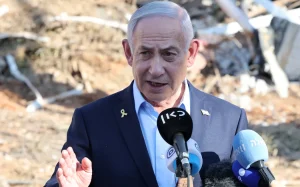Washington D.C. – In a significant development that could reshape the Middle East conflict, Hamas has announced its partial acceptance of the Trump Gaza peace plan, marking a potential turning point in the two-year-long Gaza conflict. The militant organization released a comprehensive statement outlining its agreement to key provisions while expressing gratitude to international mediators working toward peace.
Hamas Agrees to Key Provisions of Trump Gaza Peace Plan

Hamas announced its willingness to accept several critical components of the Trump Gaza peace plan after conducting extensive consultations with its leadership, Palestinian factions, and international mediators. The organization emphasized its commitment to ending what it describes as ongoing aggression against Palestinians in Gaza while defending Palestinian rights and interests.
The statement reflected Hamas’s recognition of international efforts, specifically acknowledging President Donald Trump‘s role in proposing solutions. The organization expressed appreciation for Arab, Islamic, and international parties working to end hostilities, facilitate prisoner exchanges, ensure immediate humanitarian aid entry, and prevent displacement of Palestinian populations.
Hostage Release Agreement Under Trump Gaza Peace Plan

One of the most significant aspects of Hamas’s acceptance involves the release of all remaining hostages captured during the October 7 attacks. According to the statement, Hamas agreed to release all prisoners—both living individuals and remains—following the exchange formula outlined in the Trump Gaza peace plan.
The organization emphasized that this release would occur within a framework ensuring complete cessation of hostilities and full Israeli withdrawal from Gaza. Hamas indicated its readiness to immediately enter negotiations through mediators to discuss implementation details, provided necessary field conditions for the exchange are met.
Transfer of Governance and Administrative Control

Hamas made a crucial commitment regarding Gaza’s future governance under the Trump Gaza peace plan. The organization reaffirmed its approval to transfer administrative control of Gaza to a politically independent Palestinian body composed of technocrats. This transition would be based on Palestinian national consensus and supported by Arab and Islamic backing.
This represents a significant shift in Hamas’s position, as the organization has controlled Gaza for years. The willingness to hand over power to an independent body demonstrates Hamas’s engagement with the peace process, though specific timeline details remain subject to negotiation.
Notable Omissions in Hamas’s Response
While Hamas accepted several provisions of the Trump Gaza peace plan, the statement notably avoided addressing disarmament—a key Israeli demand. The organization stated that other issues concerning Gaza’s future and Palestinian rights would be discussed within a comprehensive national framework, where Hamas would participate and contribute responsibly.
These matters are tied to collective national positions and must align with relevant international laws and resolutions, according to the statement. This strategic silence on disarmament suggests potential challenges ahead in final negotiations.
Trump Orders Immediate Cessation of Israeli Operations
Following Hamas’s partial acceptance of the Trump Gaza peace plan, President Trump ordered Israel to immediately halt bombing operations in Gaza. Trump expressed optimism about the statement, writing on social media that he believes Hamas is ready for lasting peace based on their response.
The 21-point proposal, which received backing from Israeli Prime Minister Benjamin Netanyahu, calls for ending the two-year conflict, releasing hostages within 72 hours, implementing gradual Israeli withdrawal from Gaza, and achieving Hamas’s disarmament.
Israel’s Response to Peace Plan Acceptance


Israel’s political leadership instructed its military to scale back offensive operations in Gaza following Hamas’s statement. Israeli officials announced preparations for immediate implementation of the first stage of the Trump Gaza peace plan, signaling willingness to engage with the peace process.
This de-escalation represents a crucial step toward ending hostilities that have devastated Gaza and claimed numerous lives over two years of intense conflict.
Future Governance Structure Under Trump Gaza Peace Plan
The Trump Gaza peace plan envisions a transformed governance structure for Gaza. The proposal insists that Hamas and other militant factions have no role in Gaza’s governance, with administration instead handled by a technocratic body. This body would operate under a post-war transitional authority headed by Trump himself, representing unprecedented American involvement in Palestinian governance.
The plan’s comprehensive approach addresses immediate humanitarian concerns while establishing long-term frameworks for stability, though implementation challenges remain significant.
Conclusion: A Path Forward
Hamas’s acceptance of key provisions in the Trump Gaza peace plan offers renewed hope for ending one of the region’s most intractable conflicts. While disagreements over disarmament and governance details persist, the willingness of both parties to engage through international mediators represents progress. The coming days will prove critical as negotiators work to transform this preliminary agreement into lasting peace, potentially ending two years of devastation and opening pathways toward rebuilding Gaza’s shattered infrastructure and communities.

